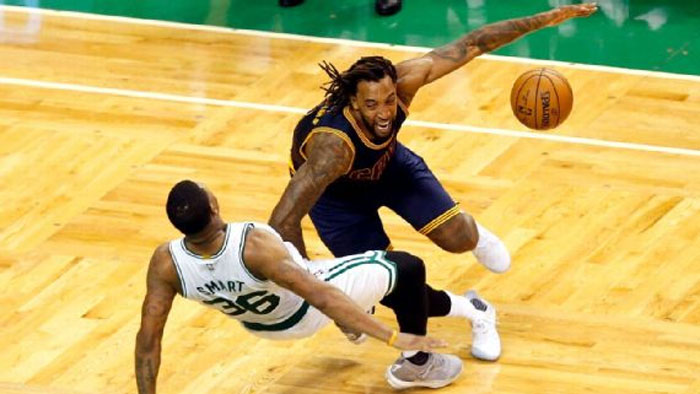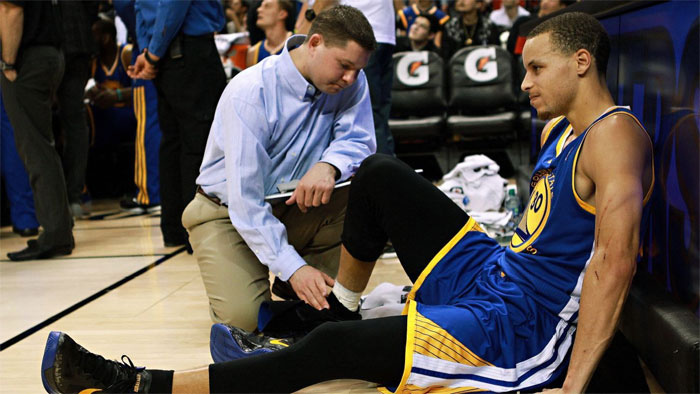While watching your favorite basketball players on the court, there’s a good chance you’ve heard an official call out “loose ball” during the game.
A loose ball occurs when players illegally grab or shove each other when struggling to regain possession of the ball. This happens when the ball is “loose.”
These fouls are most common during shot attempts and passes, and it is a fairly common foul to be called. Nevertheless, a loose ball foul can sometimes be confusing, so we’re here to clear things up.
Loose Ball Fouls Explained
A loose ball foul in basketball occurs when a player tries to regain possession of a loose ball. The player is not allowed to stop or obstruct the movement of another player in the process.
Actions such as placing your hands on an opponent, grabbing an opponent from behind, and even shoving or forcing an opponent to the floor can lead to a loose ball foul.

Greg M. Cooper/USA TODAY Sports
In simple terms, any illegal physical contact that happens as players rush in for a loose ball is considered a loose ball foul. It’s normal to see this happen as multiple players push or shove each other in their attempt to win possession.
When there is a lot of physical contact during a loose ball, it is up to the referee to decide whether the game should continue or if the foul should be called. Loose ball fouls aren’t classified either as defensive or offensive.
Personal Fouls vs. Team Fouls
A loose ball foul is classified as a personal foul. In addition, it counts towards the total tally of the offending team fouls. Whichever the referee decides to call can significantly impact the game.
Personal
A personal foul occurs when one player tries to stop or impede the movement of another player. These actions may include grabbing an opponent from behind, shoving them, or making any form of illegal contact.
If you watch a lot of basketball games, you must have seen some players trying to use their hands to block an opponent from running through them.
Six fouls during a game are grounds for ejection, and the player can no longer participate. To that end, the official can charge a player with a personal foul and cause them to “foul out,” which means the team will then need to replace them.
Team
Team fouls are the total number of personal fouls each player in a team commits over a given period. In the NBA, the total tally of team fouls resets every quarter. Once a team passes the team foul limit, the referee will award the opposing team bonus free throws for each additional foul.
Also, in the NBA, only loose ball fouls and defensive fouls count towards the team total.
Examples of Loose Ball Fouls
The referee can stop the game and call a foul to avoid a loose ball leading to injuries or an all-out brawl. Here are the reasons why a referee will call in a loose ball foul.
When Players Are Going for a Rebound After a Shot
Most loose ball fouls in basketball are awarded when players battle to regain a rebound shot. It is common to see an official award a foul when a player misses a shot, as most players often collide with each other during such periods.
A loose ball foul can occur during a two or three-point shot or free throw.
If a Defensive Player Intercepts a Pass
Quick and efficient passes from one player to another are among the main tricks teams use to put the ball in the hoop. On the other hand, a defensive player can read one of these passes and knock the ball off course.
If a player doesn’t recover the loose ball right away, both teams will rush in to regain possession of the ball. This is an opportunity for physical contact during the game, which frequently results in a foul.
When an Offensive Player Loses Possession of the Ball for No Apparent Reason
Sometimes a player might lose the ball for no obvious reason other than a bad dribble. It is another example of the ball being loose on the court when this happens. Thus there is the potential for a loose ball foul to occur.
Consequences of a Loose Ball Foul
In the case of a loose ball foul, a few things can happen. According to the NBA rule book, the offended team will win possession of the ball. The sideline spot closest to the foul will be designated as the location of possession.
Furthermore, the offended player will be awarded one free throw attempt. Additionally, if there is a penalty situation, the free throw is given in addition to the penalty throw.
Potential Outcomes of a Loose Ball
Undoubtedly, basketball players are some of the largest team athletes. Most of the players in the NBA are often over six feet tall.
Now imagine all those giants crashing into each other in an attempt to regain possession of a loose ball. The loose ball foul lessens the chances of injury and possible chaos. Some other possible outcomes include the following:

Injuries to Players
Unfortunately, some players can become aggressive in loose ball situations and may injure an opponent in the process of regaining the ball. Injuries are a common side-effect of being a professional athlete.
However, if the official calls a loose ball foul quickly, they can prevent serious harm from happening to any of the players.
Flagrant Fouls Against Players
If the referee believes the player’s actions were deliberate or excessively violent, he might call a flagrant foul instead of a loose ball foul. Officials will designate flagrant fouls as either a flagrant foul 1 or flagrant foul 2. Players can’t commit more than one flagrant 1 foul or risk being removed from the game.
For an official to call in a flagrant foul, he must carefully assess the situation. They must determine whether or not a player’s actions against an opponent were deliberate.
Technical Fouls Against Coaches
Sometimes, coaches may have strong feelings about a referee’s decision on a loose ball foul. All of the struggling to reclaim the ball happens quickly, which could confuse the referee. However, most players and coaches will express their discontent if they feel the official made a bad call.
Nonetheless, an official can call in a technical foul if a coach or player becomes too agitated by his decision.
How to Draw or Avoid a Loose Ball Foul
Making every effort to reach the ball first is the easiest way to draw a loose ball foul. If you manage to get the ball first, turn around and face the defender with your backside to force a foul. Doing this will give you the leverage you need to make the situation look like a foul.
Comparatively, the best way to prevent a loose ball foul is to avoid any form of illegal contact with an opponent reaching for the ball. Try to focus more on regaining possession of the ball rather than fouling the player. You can also take the time to study the official rule book if you want to know more about these types of fouls.
Conclusion: Loose Ball Fouls in Basketball
A lot of grabbing and struggling happens when players try to regain possession of a loose ball. An official will award a loose ball foul when one player makes illegal contact with another player.
Furthermore, if a player or coach becomes excessively agitated about an official’s decision, the referee can award a flagrant foul or a technical foul. Additionally, the best way to avoid these types of fouls is to avoid making illegal contact with an opponent contesting for the ball.
